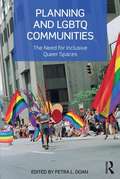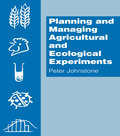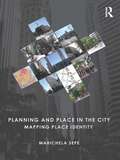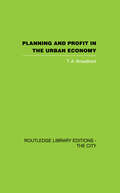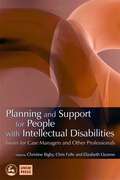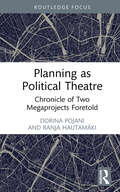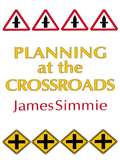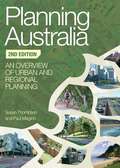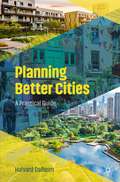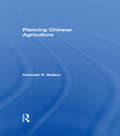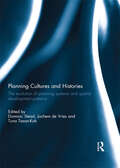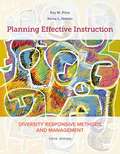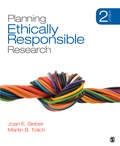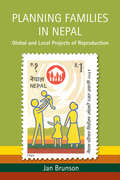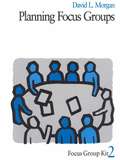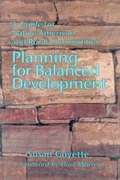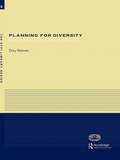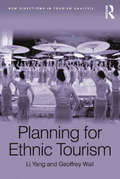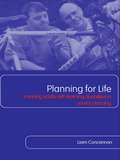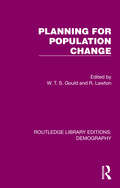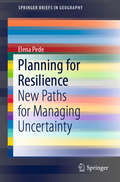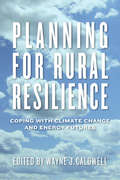- Table View
- List View
Planning and LGBTQ Communities: The Need for Inclusive Queer Spaces
by Petra L. DoanAlthough the last decade has seen steady progress towards wider acceptance of lesbian, gay, bisexual, transgendered, and queer (LGBTQ) individuals, LGBTQ residential and commercial areas have come under increasing pressure from gentrification and redevelopment initiatives. As a result many of these neighborhoods are losing their special character as safe havens for sexual and gender minorities. Urban planners and municipal officials have sometimes ignored the transformation of these neighborhoods and at other times been complicit in these changes. <p><p> Planning and LGBTQ Communities brings together experienced planners, administrators, and researchers in the fields of planning and geography to reflect on the evolution of urban neighborhoods in which LGBTQ populations live, work, and play. The authors examine a variety of LGBTQ residential and commercial areas to highlight policy and planning links to the development of these neighborhoods. Each chapter explores a particular urban context and asks how the field of planning has enabled, facilitated, and/or neglected the specialized and diverse needs of the LGBTQ population. <p> A central theme of this book is that urban planners need to think "beyond queer space" because LGBTQ populations are more diverse and dispersed than the white gay male populations that created many of the most visible gayborhoods. The authors provide practical guidance for cities and citizens seeking to strengthen neighborhoods that have an explicit LGBTQ focus as well as other areas that are LGBTQ-friendly. They also encourage broader awareness of the needs of this marginalized population and the need to establish more formal linkages between municipal government and a range of LGBTQ groups. Planning and LGBTQ Communities also adds useful material for graduate level courses in planning theory, urban and regional theory, planning for multicultural cities, urban geography, and geographies of gender and sexuality.
Planning and Managing Agricultural and Ecological Experiments
by Johnstone, PeterA text addressing the essential issues required to undertake satisfactory comparative agricultural and ecological experiments. It offers an integrated presentation, with the focus strongly placed on the planning and execution of experiments.
Planning and Place in the City: Mapping Place Identity
by Marichela SepeUnder the influence of globalization, the centres of many cities in the industrialised world are losing their place identity, the set of cultural markers that define a city’s uniqueness and make it instantly recognisable. A key task for planners and residents, working together, is to preserve that unique sense of place without making the city a parody of itself. In Planning and Place in the City, Marichela Sepe explores the preservation, reconstruction and enhancement of cultural heritage and place identity. She outlines the history of the concept of placemaking, and sets out the range of different methods of analysis and assessment that are used to help pin down the nature of place identity. This book also uses the author's own survey-based method called PlaceMaker to detect elements that do not feature in traditional mapping and identifies appropriate planning interventions. Case studies investigate cities in Europe, North America and Asia, which demonstrate how surveys and interviews can be used to draw up an analytical map of place identity. This investigative work is a crucial step in identifying cultural elements which will influence what planning decisions should be taken in the future. The maps aim to establish a dialogue with local residents and support planners and administrators in making sustainable changes. The case studies are amply illustrated with survey data sheets, photos, and coloured maps. Innovative and broad-based, Planning and Place in the City lays out an approach to the identification and preservation of place and cultural heritage suitable for students, academics and professionals alike.
Planning and Power in Iran: Ebtehaj and Economic Development under the Shah
by Geoffrey Jones Frances BostockFirst Published in 1989. Routledge is an imprint of Taylor & Francis, an informa company.
Planning and Profit in the Urban Economy
by T.A. BroadbentFirst Published in 2006. This text tries to answer some of the questions posed in the introduction to the British edition of 'After the Planners'- what is the relationship between government and industry and what is the role of planning within his relationship.
Planning and Support for People with Intellectual Disabilities: Issues for Case Managers and Other Professionals
by Thomas J. Willis Elizabeth Ozanne Gary W. Lavigna David Green Susana Gavidia-Payne Peter Flynn Margaret Flynn Paul Ramcharan Kelley Johnson Estelle Fyffe Lesley Gough Margaret Spencer Tim Stainton Brenda Burgen Colin Hiscoe Janet Robertson Jim Mansell Gordon Grant Eric Emerson Marie Knox Susan Balandin David Sykes Christine M Bigby Chris Fyffe Gwynnyth Llewellyn Phillip Graves'Thought-provoking, well-written, and offering a range of fresh and sometimes challenging perspectives, Planning and Support should be essential reading for people working in the field of learning disabilities. Highly recommended.' - Involve Magazine The authors outline the skills needed and common issues in case management practice across a range of people with different disabilities at different stages of their life. Emphasising the importance of taking a rights-based approach to supporting people with learning disabilities, the authors argue that effective case management needs to be individualised and carried out in partnership with the individual and their family in order to draw up a lifestyle plan that meets their many needs, including employment, education, vocational training, therapy and behaviour support. The book includes chapters on inter-agency and cross-sector negotiation and collaboration, balancing rights and protection, listening to individuals and families, communication, optimising health outcomes, approaches to behaviour support, ethical decision-making and reflective supervision, and the text is complemented by case studies throughout. An essential reference for practitioners, the book is also an invaluable guide for policy makers, researchers and students, nurses, carers, and people with intellectual disabilities and their families.
Planning as Political Theatre: Chronicle of Two Megaprojects Foretold (Routledge Focus on Urban Studies)
by Dorina Pojani Ranja HautamäkiThis book examines two large and highly controversial urban infill projects in two peripheral European capitals—Tirana and Helsinki—through the lens of dramaturgy and political theatre. The authors argue that the planning processes in both cities have been farcical, following the so-called ‘disillusionment arc’ in storytelling—that is, coming to terms with the inevitability of private developments where vast sums of money are at stake and power does not rest with the people. Beyond these case studies, the book introduces the concept of ‘planning distortion’ which blends socio-institutional phenomena such as corruption, neoliberalism, and undemocratisation. It will appeal to planning theorists and readers interested in the European periphery, particularly the Nordics and the Balkans.
Planning At The Crossroads
by James SimmieThrough a detailed analysis of studies of the effects of planning, comparing low levels of urban containment in California with much higher levels in the UK. Some comparative insights are also drawn from the (pre-conflict) Yugoslavian planning system. The analysis shows that many of the serious criticisms of planning are valid and leads to the conclusion that some sacred cows - notably "green belts" - should be abandoned. This distinctive text is of use to students, researchers and professionals in planning, geography and urban studies.
Planning Australia: An Overview of Urban and Regional Planning
by Susan Thompson Paul J. MaginnPlanning Australia provides a comprehensive introduction to the major issues and activities that constitute urban and regional planning in Australia today. Incorporating contemporary theory and practice, it contextualises planning in terms of its theoretical, ideological and professional foundations. The book adopts an interdisciplinary approach to the subject, underpinned by the principles of sustainability and social equity. It canvasses the history of the discipline, its relationship to broader governance structures and its legislative framework. Fully revised and updated, this edition features new chapters on healthy planning and transport planning. Written in an accessible style and richly illustrated with instructive case study examples, Planning Australia is an indispensable resource for students, practitioners and decision-makers, as well as anyone interested in the history and future of planning in Australia.
Planning Better Cities: A Practical Guide
by Halvard DalheimThis textbook provides an accessible, practical guide to the strategic planning process required for the preparation of city plans from entire metropolitan areas to town centres. It fills a gap in the academic literature on the topic of strategic planning. Its conceptual and practical content together with a student friendly style and high use of practical examples make it accessible to both the student and recent graduate. Its presentation in three parts allows the reader or course leader to access those sections relevant to either their learning requirements or day-to-day work activities. The book is clearly structured into three-parts and provides flexibility in approach and learning for students taking relevant planning courses. The extensive reading list at the conclusion of each chapter provides the student with an opportunity to explore in more detail the individual topics. The practical approach equips the recent graduate with a deeper understanding of the purpose of each element of strategic planning from how to prepare a research brief to how to approach community engagement activities.
Planning Chinese Agriculture
by Kenneth R WalkerFirst Published in 1965. Routledge is an imprint of Taylor & Francis, an informa company.
Planning Complex Waterfront Interfaces: Reshaping Port City Regeneration for Sustainable Urban Futures (UNIPA Springer Series)
by Maurizio Carta Paolo La Greca Daniele Ronsivalle Barbara LinoThis book presents a comprehensive examination of the complex interactions between port systems and urban environments, with a particular focus on international methodologies and site-specific case studies from the waterfronts of Palermo and Catania and the West Sicily Sea Authority. It addresses the multifaceted challenges and opportunities inherent in waterfront regeneration, emphasizing the critical importance of developing new urban interfaces that seamlessly connect ports to their surrounding cities. These interfaces serve not only as physical transitions but also as vital cultural and economic linkages that foster community engagement and enhance the liveability of urban spaces. The work offers a series of detailed analyses that highlight the necessity of integrating heritage protection within contemporary urban planning frameworks. By exploring historical developments and current initiatives, it provides valuable insights applicable to diverse global contexts, making it relevant for policymakers, urban planners, and scholars dedicated to understanding the future of port cities. Through rigorous exploration of strategic planning and stakeholder engagement, this book highlights pathways toward innovative solutions that respect historical contexts while advancing sustainable urban futures. By prioritizing the creation of effective urban interfaces, it contributes to the broader discourse on port-city relationships worldwide, underscoring their significance in shaping resilient and vibrant urban environments.
Planning Cultures and Histories: The evolution of Planning Systems and Spatial Development Patterns
by Dominic Stead, Jochem de Vries and Tuna Tasan-KokThis book addresses the influences of planning cultures and histories on the temporal evolution of planning systems and spatial development. As well as providing an international comparative perspective on these issues, the contributions to the book also engage in a search for new conceptual frameworks and alternative points of view to better understand and explain these differences. The book makes three main academic contributions. First, it catalogues some of the key changes in planning systems and the impact on spatial development patterns. Second, it examines the interrelationship between planning cultures and histories from a path-dependency perspective. Third, it discusses the variations in physical development patterns resulting from different planning cultures and histories. Chapters from different parts of the European continent present evidence at different scales to illustrate these aspects. In all cases, the specific combinations of political, ideological, social, economic and technological factors are important determinants of urban and regional planning trajectories as well as spatial development patterns. This book was previously published as a special issue of European Planning Studies.
Planning Effective Instruction: Diversity Responsive Methods And Management (Mindtap Course List Series)
by Kay Price Karna NelsonPLANNING EFFECTIVE INSTRUCTION: DIVERSITY RESPONSIVE METHODS AND MANAGEMENT, 6th Edition, translates best practice research into practical suggestions for diversity responsive teaching in the classroom. The book is organized around a framework that clarifies the enormous task of being a diversity responsive teacher by helping focus teachers' efforts in planning for diversity. Readers see that what they teach, how they teach, and the context for teaching interact to bring about the success of all students. Written lesson and activity plans that incorporate diversity responsive techniques guide and save time for future instructors. The book -- which integrates InTASC Standards and includes learning objectives -- provides resources and exercises that both lay the foundation for readers' future work and prove useful as tools that they can reference throughout their teaching careers.
Planning Ethically Responsible Research
by Joan E. Sieber Professor Martin TolichExtensively revised and updated to serve today's needs for insight and solutions to the most vexing ethical and regulatory problems faced by researchers today, Planning Ethically Responsible Research, Second Edition guides readers through one of the most important aspects of their social or behavioral research: planning ethically responsible research. Authors Joan E. Sieber and Martin B. Tolich offer invaluable, practical guidance to researchers and graduate students to understand ethical concerns within real-life research situations, satisfy federal regulations governing human research, and work with the university's Institutional Review Board (IRB). The book includes an abundance of useful tools: detailed instructions on development of an effective IRB protocol; methods for handling issues of consent, privacy, confidentiality and deception; ways to assess risk and benefit to optimize research outcomes; and how to respect the needs of vulnerable research populations.
Planning Families in Nepal: Global and Local Projects of Reproduction
by Jan BrunsonBased on almost a decade of research in the Kathmandu Valley, Planning Families in Nepal offers a compelling account of Hindu Nepali women as they face conflicting global and local ideals regarding family planning. Promoting a two-child norm, global family planning programs have disseminated the slogan, "A small family is a happy family," throughout the global South. Jan Brunson examines how two generations of Hindu Nepali women negotiate this global message of a two-child family and a more local need to produce a son. Brunson explains that while women did not prefer sons to daughters, they recognized that in the dominant patrilocal family system, their daughters would eventually marry and be lost to other households. As a result, despite recent increases in educational and career opportunities for daughters, mothers still hoped for a son who would bring a daughter-in-law into the family and care for his aging parents. Mothers worried about whether their modern, rebellious sons would fulfill their filial duties, but ultimately those sons demonstrated an enduring commitment to living with their aging parents. In the context of rapid social change related to national politics as well as globalization--a constant influx of new music, clothes, gadgets, and even governments--the sons viewed the multigenerational family as a refuge. Throughout Planning Families in Nepal, Brunson raises important questions about the notion of "planning" when applied to family formation, arguing that reproduction is better understood as a set of local and global ideals that involve actors with desires and actions with constraints, wrought with delays, stalling, and improvisation.
Planning Focus Groups
by David L. MorganDavid L Morgan covers the wide range of practical tasks required in the course of a research project when using focus groups. Throughout, Planning Focus Groups emphasizes the clarifying purposes of the research project in order to collect data that meet the goals. The author extensively and concisely covers the basic decisions that are necessary to plan a research project using focus groups, such as who should be in the groups, the total number of groups, their size and much more. This volume also features a detailed discussion of personnel and budgets. Among the other topics covered are recruitment, selecting locations, and recording and managing data. Practical material includes checklists and recruitment tools.
Planning for Balanced Development: A Guide for Native American and Rural Communities
by Susan GuyetteGuyette presents the first field-tested model of development planning that addresses the special concerns of Native American and rural communities. In Guyette's model, revitalizing cultural traditions becomes the central focus of the economic planning process.
Planning for Diversity: Policy and Planning in a World of Difference (RTPI Library Series #Vol. 8)
by Dory ReevesThe practical importance of diversity and equality for spatial planning and sustainable development is still not widely understood. Using international examples, this book shows planners and educationalists the benefits of building in a consideration of diversity and equality at each stage and level of planning.Despite being one of the most diverse and gender balanced of the built environment professions, complacency has been widespread in planning. This book shows why a diverse profession is important and drawing on a wide range of good practice, shows how those involved in planning can develop their sensitivity to and expertise in diversity and equality.
Planning for Equitable Urban Agriculture in the United States: Future Directions for a New Ethic in City Building (Urban Agriculture)
by Samina Raja Marcia Caton Campbell Alexandra Judelsohn Branden Born Alfonso MoralesThis open access book, building on the legacy of food systems scholar and advocate, Jerome Kaufman, examines the potential and pitfalls of planning for urban agriculture (UA) in the United States, especially in how questions of ethics and equity are addressed. The book is organized into six sections. Written by a team of scholars and practitioners, the book covers a comprehensive array of topics ranging from theory to practice of planning for equitable urban agriculture. Section 1 makes the case for re-imagining agriculture as central to urban landscapes, and unpacks why, how, and when planning should support UA, and more broadly food systems. Section 2, written by early career and seasoned scholars, provides a theoretical foundation for the book. Section 3, written by teams of scholars and community partners, examines how civic agriculture is unfolding across urban landscapes, led largely by community organizations. Section 4, written by planning practitionersand scholars, documents local government planning tied to urban agriculture, focusing especially on how they address questions of equity. Section 5 explores UA as a locus of pedagogy of equity. Section 6 places the UA movement in the US within a global context, and concludes with ideas and challenges for the future. The book concludes with a call for planning as public nurturance – an approach that can be illustrated through urban agriculture. Planning as public nurturance is a value-explicit process that centers an ethics of care, especially protecting the interests of publics that are marginalized. It builds the capacity of marginalized groups to authentically co-design and participate in planning/policy processes. Such a planning approach requires that progress toward equitable outcomes is consistently evaluated through accountability measures. And, finally, such an approach requires attention to structural and institutional inequities. Addressing these four elements is more likelyto create a condition under which urban agriculture may be used as a lever in the planning and development of more just and equitable cities. This is an open access book.This is an open access book.
Planning for Ethnic Tourism (New Directions in Tourism Analysis)
by Li Yang Geoffrey WallEthnic tourism has emerged as a means that is employed by many countries to facilitate economic and cultural development and to assist in the preservation of ethnic heritage. However, while ethnic tourism has the potential to bring economic and social benefits it can also significantly impact traditional cultures, ways of life and the sense of identity of ethnic groups. There is growing concern in many places about how to balance the use of ethnicity as a tourist attraction with the protection of minority cultures and the promotion of ethnic pride. Despite the fact that a substantial literature is devoted to the impacts of ethnic tourism, little research has been done on how to plan ethnic tourism attractions or to manage community impacts of tourism. This book addresses the need for more research on planning for ethnic tourism by exploring the status and enhancement of planning strategies for ethnic tourism development. The book develops the case of a well-known ethnic tourist destination in China -Xishuangbanna, Yunnan. It analyzes how ethnic tourism has been planned and developed at the study site and examines associated socio-cultural and planning issues. The authors evaluate the perspectives of four key stakeholder groups (the government, tourism entrepreneurs, ethnic minorities and tourists) on ethnic tourism through on-site observation, interviews with government officials, planners and tourism entrepreneurs, surveys of tourists and ethnic minority people, and evaluation of government policies, plans and statistics. This book is unique in its emphasis on planning and in its focus on China, rapidly emerging as a major player in tourism, with applications for tourism around the world.
Planning For Life: Involving Adults with Learning Disabilities in Service Planning
by Liam ConcannonThis book traces the development of services for people with disabilities and discusses how much things have really changed for today's 'service users' since the days of asylums. It also assesses whether the policy of involvement, such as that outlined in Valuing People, is achievable in practice or simply places unrealistic burdens on professionals and service users.Based on findings from original research and interviews, the author argues that involving people with learning disabilities in service planning is difficult to achieve successfully and is currently, to a large extent, tokenistic. This area of challenging practice and emotive debate is brought to life by the voices of service providers, carers and the service users themselves, and illustrates the realities of working with people with learning disabilities.Planning for Life is valuable and informative for students of social work, social care and social policy, and will be enlightening reading for those working with adults with learning disabilities, in policy and in practice.
Planning for Population Change (Routledge Library Editions: Demography #6)
by W. T. S. GouldOriginally published in 1986, this book explores many important aspects of the relationship between population change and planning, exploring the impact of population change on service provision and its impact on the policy-making process. In all countries, whether their population is expanding. ageing or stagnating, population mobility is an important cause of economic and social development. This book argues that there is a need for greater sensitivity about population change in policy-making and service provision and suggests ways of achieving this.
Planning for Resilience: New Paths for Managing Uncertainty (SpringerBriefs in Geography)
by Elena PedeGiven the increasing uncertainty due to catastrophic climate events, terrorist attacks, and economic crises, this book addresses planning for resilience by focusing on sharing knowledge among policy-makers, urban planners, emergency teams and citizens. Chapters look at the nature of contemporary risks, the widespread of resilience thinking and the gap between the theoretical conception and the practices. The book explores how resilience implies a change in planning practices, highlighting the need for flexibility in terms of procedures, and for dynamism in the knowledge systems and learning processes that are the main tools for interaction among different actors and scales. Given its breadth of coverage, the book offers a valuable resource for both academic readers (spatial planners, geographers, social scientists) and practitioners (policymakers, citizens’ associations).
Planning for Rural Resilience: Coping with Climate Change and Energy Futures
by Wayne J. Caldwell Erica Ferguson Emanuel Lapierre-Fortin Jennifer Ball Suzanne Reid Paul Kraehling Eric Marr John Devlin Chris White Tony Mcquail Margaret Graves Bill Deen Ralph Martin Christopher BryantClimate change and an evolving non-renewable energy sector threaten the future viability and sustainability of communities across the country. While rural communities have a special place in the national fabric, they often lack the resources to tackle these important and evolving threats. Planning for Rural Resilience: Coping with Climate Change and Energy Futures makes clear that communities and municipalities have opportunities to make informed and constructive decisions in the face of uncertainty: many of these decisions are “win-win” in the sense that they benefit the community in the short term while also building resilience for the future. Case studies include a town rebuilding itself after a tornado and an individual farmer’s commitment to creating a resilient farm. They provide examples of innovative, successful, and practical on-the-ground actions and strategies. Planning for Rural Resilience asks central questions about the nature of change and the ability to adapt in rural regions. While change is often feared, communities have capacity that can be rallied, harnessed, and turned towards planning policy and action that responds to threats to the future. This important work will assist municipal decision makers, planners, and community members as well as anyone who has a passion for the future and betterment of rural life.
